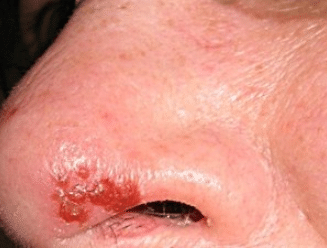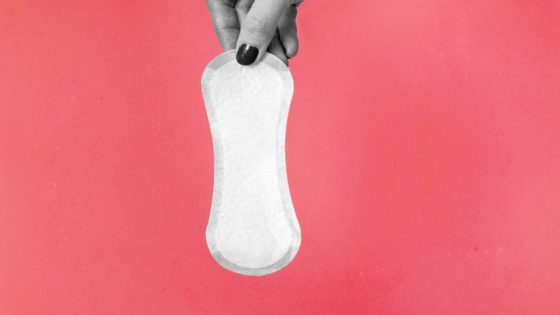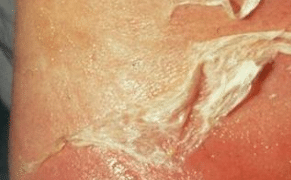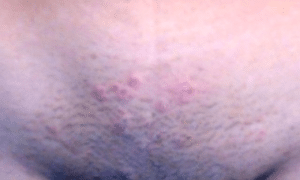Can you get a cold sore on your nose? Here is an insight on causes of cold sores on nose, symptoms, treatment and pictures.
Cold Sore on Nose – Causes
Cold sores are fluid filled blisters that appear mainly around the mouth and on the nose. These cold sores are less common on the fingers, face, and inside the mouth. These sores appear in clusters just like patches. The can take a longer period before they disappear.
Cold sores are caused by a common virus known as the herpes simplex virus. The herpes simplex virus occurs in two categories. The herpes simplex virus type 1 (HSV1) which mainly results in cold sores while herpes simplex virus type 2 (HSV2) which causes genital herpes.
These virus spread from one person to another through close contact like deep kissing. These cold sores are said to be contagious even if they are less visible. The fluid filled blisters of the two types of the viruses have the same appearance regardless of the place they occur.
Cold sores on the nose do go away on their after some time and it is recommended not to prick them. Picking the sores on the nose postpones healing and it can even result in an infection. Recurring cold sores require immediate medical attention from a specialist.
Also, cold sores can result due to allergies from the foods, dust, pollen grains and certain medication. They do develop when the body releases certain substance in response of fighting the allergens. Consult a medical doctor for prescription in order to curb these fluid filled blisters around the mouth and nose.
Cold sores do appear to people with medical problems and weak immune system. Some of the common medical conditions like HIV/AIDs, immune system weaken by chemotherapy, viral infection, and severe burns.
Hormonal imbalances in women during and after menstruation may evoke the outbreak of the cold sores on the nose and other parts of the body. The research also shows that stress can be a factor behind the appearance of the cold sores.
Cold Sore under Nose
The virus that causes cold sores can be found in the body but they are said to be inactive since the viruses are incurable. This is the reason why they are contagious whether they are visible or not visible. There is some research that shows that they can be transmitted through close contact like kissing.
According to WebMD, the general transmission of the virus is through deep kissing, sharing foods and drinks in the same cup with the infected person. They are highly contagious.
The viruses tend to remain inactive in the body and most of us we were infected when young. The present of the viruses in the body does not mean we can get infection immediately. The viruses can remain dormant for some days before showing up as blisters.
According to the research done by experts in our company, the most contagious periods on the virus are when the blister has appeared. When the blisters have dried and crusted, the risk of spreading reduces. The fact remains that the infection can pass from one person to another even when blisters are not present.
Once the fluid filled blisters are healed, the virus remain inactive in the body for a longer period of time before they are triggered and immediately they are triggered, they begin to form cold sores around the mouth and nose.
The following are the common factors that trigger the appearance of cold sores:
- Fatigue
The combination of fatigue and stress can result in the appearance of cold sores since there are certain substances that are released by the body that may trigger the virus to become active.
- Hormonal changes
This is the main factor among women during and after ovulation. The sudden changes in the hormones may trigger the appearance of cold sores among women mostly during pregnancy, menopause and menstruation.
- Cold weather
During winter, many people always complain of cold sores on the nose. Also sunburn and trauma can result in the appearance of cold sores.
Cold Sore on Nose Stages
Cold sores do occur in different stages during its life time. Each stage is marked by its own features and symptoms. Understanding each stage enables a person to treat them with the appropriate remedy. The research shows that herpes simplex viruses are spread easily at some stages of its development.
Some of the common stages include:
- Tingling
- Blistering
- Weeping
- Crusting
- Healing
Tingle stage
It is also known as prodrome stage. It is the initial stage of the infection in the body and it is always considered as day one. During this stage, viruses multiply very fast in the body. How long do tingling stage last? It takes some hours or days before the blisters begin to appear.
The symptoms of this stage are less visible and a person feel them rather than seeing them. The common signs and symptoms of cold sores during the tingling stage include the following:
- A burning sensation around the mouth, lips and nose
- The urge of itching, stinging or tingling emerges
- Although on rare occasion, there will be a slight swelling and soreness on the site of the cold sore.
Treatment at early stages
Curing of the viruses causing the infection at this early stage is more effective. The use of antiviral prescription can help to halt the multiplication of the viruses in the body. At home there are some remedies a person can follow in order to curb the viruses in the body.
- The viruses thrive well in acidic environment. Therefore, it is recommended to avoid acid foods or substance and even drinks. Drink plenty of water instead.
- Uses swab cotton balls soaked in alcohol and apply on the blister. Alcohol keeps the skin dry and inhibits the growth of the cold sores.
The blistering stage
It is also known as bubble stage. It is the second stage of the cold sores. The stage is characterized by the appearance of sores or lesion on the skin around the nose or mouth. Most on these blisters are fluid filled. The fluid can either be clear or yellowish in color. These fluid filled lesions are usually surrounded by a red ring or halo. They form yellow crust after rupturing.
Most of these blisters during this stage are usually painful. The blisters may inhibit breathing, talking, eating laughing, yawning and general movement of the skin around the site to be uncomfortable.
Treatment of the blistering stage
These blister last for some days on the skin around the site. The use of cold or ice compress can help reduce the swelling and the pain on the site. Gently apply the ice pack on the blister for some days. Avoid popping the blister at whatever cost.
The use of over the counter painkillers can help to reduce the pain and the inflammation experience by the blisters. Picking the cold sores may increase the chances of spreading from one point to another and in some circumstance result in bacterial infection and permanent scars.
The weeping stage
It is also known as ulcer stage due to the present of the blisters at this stage. At this stage, there is a lot of bleeding since the blisters mainly rapture and result in an open sore. The bursting of the lesion result in oozing of yellow substance or blood or clear fluid.
The open lesion turns to gray and become tender. The stage is considered to be the most painful. The fluid leaking from the blisters comprises of newborn viruses.
Treatment
According to the National Health Service, cold sores are considered to be highly contagious when they burst but they can also be contagious until they heal completely. It seems difficult to avoid affecting other people when the blisters burst.
Avoid coming in close contact with affected person either through deep kissing or sexual intercourse. These activities increase the chances of spreading of the infection.
Crust or scab stage
This is almost the last stage of healing process where the blisters develop scabs which may crack and bleed. The yellow crust forms as a result of fluid coming out during the earlier stage and it dries up. The crusted scab may itch and one may experience burning sensation on the site.
Treatment
The urge to itching may result in bleeding. Moisturize the scab in order to manage the pain and the bleeding. The use a good moisturizer helps to heal the scab faster and it may fall of as time goes by. Also, it is not advisable to pull of the scabs from the cold sores.
Healing stage of a cold sore
This is the final stage where the site infected return to its original state. Despite the virus living in the nerves, it does not result in permanent scars after healing completely. The skin may appear red or pink on the affected part of the skin. There will little swellings and bleeding due to the urge to itch.
Treatment
During this period of healing, it is advisable to avoid kissing or sharing utensils, oral sex and other ways that can transmit the virus to other people. Avoid touching and peeling of the scabs from the cold sores since it can spread the infection to other places.
Pictures and Images of Cold Sores Stages
As from the above mentioned stages, each stage has its own symptoms and these give different stages unique appearances. Therefore, the initial stage does not show any visible symptoms. The second stage shows the appearance of blisters or bumps on the infected site.
The third stage shows the leaking blisters that discharge infectious fluid. Crusting and scabbing appear on the fourth stage while the last stage is the healing process where the site may form a scar though not permanent.
The images and pictures show the various signs and symptoms of the stages of the cold sores and how these blisters look like.
Symptoms of a Cold Sore on Nose
The research done by experts’ show that cold sores on the nose and around the mouth pass through different stages. Each stage has its own symptoms and treatments. Some of the stages with the symptoms include:
Tingling and itching
An individual may experience the urge of itching, burning or tingling sensation around the site for some days. After some days small, hard, painful spot appears and blisters erupt.
Blistering
This is the stage where there is appearance of small fluid filled bumps on the site like around the mouth, face and even on the nose. The cold sores can also appear on the cheeks and the around the lips of the mouth.
Oozing and crusting
The small blisters may merge and then burst; leaving shallow open sores that will ooze fluid and then crust over.
The common signs and symptoms of cold sores include:
- Fever
- Painful eroded gums
- Sore throat
- Headache
- Muscle aches
- Swollen lymph nodes
Note: It is advisable to stay away from the following factors that may trigger the appearance of cold sores on the nose and even around the mouth or lips. These factors include:
- Viral infection or fever
- Hormonal changes, such as those related to menstruation
- Stress
- Fatigue
- Exposure to sunlight and wind
- Changes in the immune system
How to Get Rid of Cold sore on Nose
The natural remedies of cold sores on the nose include:
- Drink Plenty of Fluids
90 percent of our body is consisting of water and intake of plenty of water helps the body to flush out any harmful substance and infections. The presence of plenty of water in the body helps to reduce inflammation caused by the cold sores.
Intake of cucumber help to provide more fluid in the body and in the process play a vital role of getting rid of substance that result in the formation of cold sores.
It is also advisable to stay away from citrus juices such as orange, pineapple, and grapefruit despite vitamin C being essential for healing. The acid in these fruit juices will aggravate cold sores only more.
It is recommended to drink warm teas made from ginger since it helps to heal the cold sores in the nose. Grate two teaspoons or slice a couple pieces of ginger and boil in hot water. Steep the ginger and water together for 15 minutes, strain, and enjoy a warm cup of tea.
- Vitamin C
This component does not cure cold sores but it help in alleviating symptoms and keep the colds from becoming too serious. When experiencing painful sores in the nose, stay away from the citrus fruit since the acidic content might aggravate the symptoms.
Incorporate other supplements of vitamin C in the diet to help prevent cold sores in the nose and cold sores in general. Some of the common food rich in vitamin C include; strawberries, cantaloupe, red and green peppers, and broccoli.
Note: Use foods with ample vitamin C content will ensure you are fighting off a more painful and intensified experience with cold sores in the nose.
- Saline Nasal Rinse
This is the home natural remedy that is widely used to help gets rid of cold sores. Saline solution is a gentle antiseptic and therefore, it helps clean the infected area and dry out any bacteria on the skin’s surface.
Dissolve a few tablespoons of salt in warm water and apply it to the infected nasal opening. It also plays a role of clearing the blocked nasal passages and eases sinus issues. It again help to ease the inflammation and severity of cold sores found in the nose and lips.
- Witch Hazel
This is a natural astringent that is found in most homes and it helps to treat cold sores and works well for common skin irritation. The properties witch hazel contains are unparalleled when it comes to getting rid of cold sores quickly and is highly recommended to those that suffer from this bacteria infecting the nose.
Applying witch hazel directly to the cold sore is most effective and should be done at the onset of the cold sore within the nose. Witch hazel helps in faster healing of the cold sores on the nose or around the mouth.
- Increase Lysine Intake
It contains some compounds that help to reacts with the virus responsible for cold sores by fighting the infection from within the body. There are a host of different supplements you can purchase from any health food store.
It is very helpful to take lysine on a regular basis if you suffer from cold sores in the nose or cold sores in general. Some of the common foods that contain lysine include; fresh fish, beans, cheese, and most vegetables.
- Ginger Paste
It plays some vital role of getting rid of some ailments and is great for the common cold and flu, helping to clear symptoms and keep mucus and phlegm at bay.
Apply the paste with a Q-tip on the cold sores to reduce the spread of infection. Let the paste sit on the cold sore for up to 20 minutes. You will notice once rinsing the paste off the infected area that inflammation is greatly reduced and painful symptoms taken away right along with it.
- Add Probiotics to Your Diet
Probiotic capsules can be purchased at most health food stores and major grocery stores that carry supplements as well. These supplements help to introduce healthy bacteria to the system. The most common type of food rich in these compounds include; yogurt, Cheese and cottage cheese.
- A & D Ointment
This ointment, rich in both vitamins A and D, helps to kill the harmful bacteria that are responsible for the onset of cold sores in the nose. When the skin itself is fortified with these powerful vitamins, it can better fight the bacterial infection that causes cold sores in the nose that are brought on by cold and flu-like symptoms.
Apply the ointment directly to the infected area with a Q-tip or cotton swab so as to avoid spreading the infection to other parts of the body. If the cold sore is deep inside the nose, a Q-tip is the best way to get the ointment on the infection.
Ways to Prevent Cold Sores In The Nose
They include:
- Avoid Contact with Someone with Herpes Simplex like deep kissing
The herpes simplex virus is highly contagious and can be easily contracted through someone that is carrying the virus. If you notice someone who has cold sores it is highly recommended that you stay away from this individual, especially if you’ve got a compromised immune system.
- Eat Well and Exercise
Good eating habits and regular exercise will dramatically help keep cold sores in the nose at bay. Proper nutrition gives the body everything it needs to fight infection and having a diet that is balanced with fruits, vegetables, whole grains, and lean protein will set the body up for success in preventing cold sores from forming.
- Reduce Stress
Stress plays a huge role in the health of our bodies and is one of the largest precursors for disease. Cold sores are often brought on by stress and taking measures to reduce stress in your life is an excellent preventative measure.
Taking time to exercise and eat well will greatly reduce stress as will finding the time to rest from your busy schedule. The body cannot function properly on high levels of stress and too little rest, and it is pertinent that you do what you can to get the rest you need and lower stress levels.
FURTHER REFERENCES
- Home Treatments for Cold Sores: http://thesurvivaldoctor.com/2013/02/21/home-treatments-for-cold-sores/
- Painful Sores In Nose – Causes, Symptoms And Treatment For Cold Sores: http://bestremedyideas.com/causes-of-painful-sores-in-nose-symptoms-and-treatment-for-sores
- Cold Sore Stages: https://www.livestrong.com/article/242371-cold-sore-stages/
- Cold Sores in Nose: Causes, Symptoms, Treatment and Home Remedies: https://www.nlda.org/cold-sores-in-nose-causes-symptoms-treatment-and-home-remedies/
- What are cold sores? https://www.healthline.com/health/herpes-labialis#overview1











